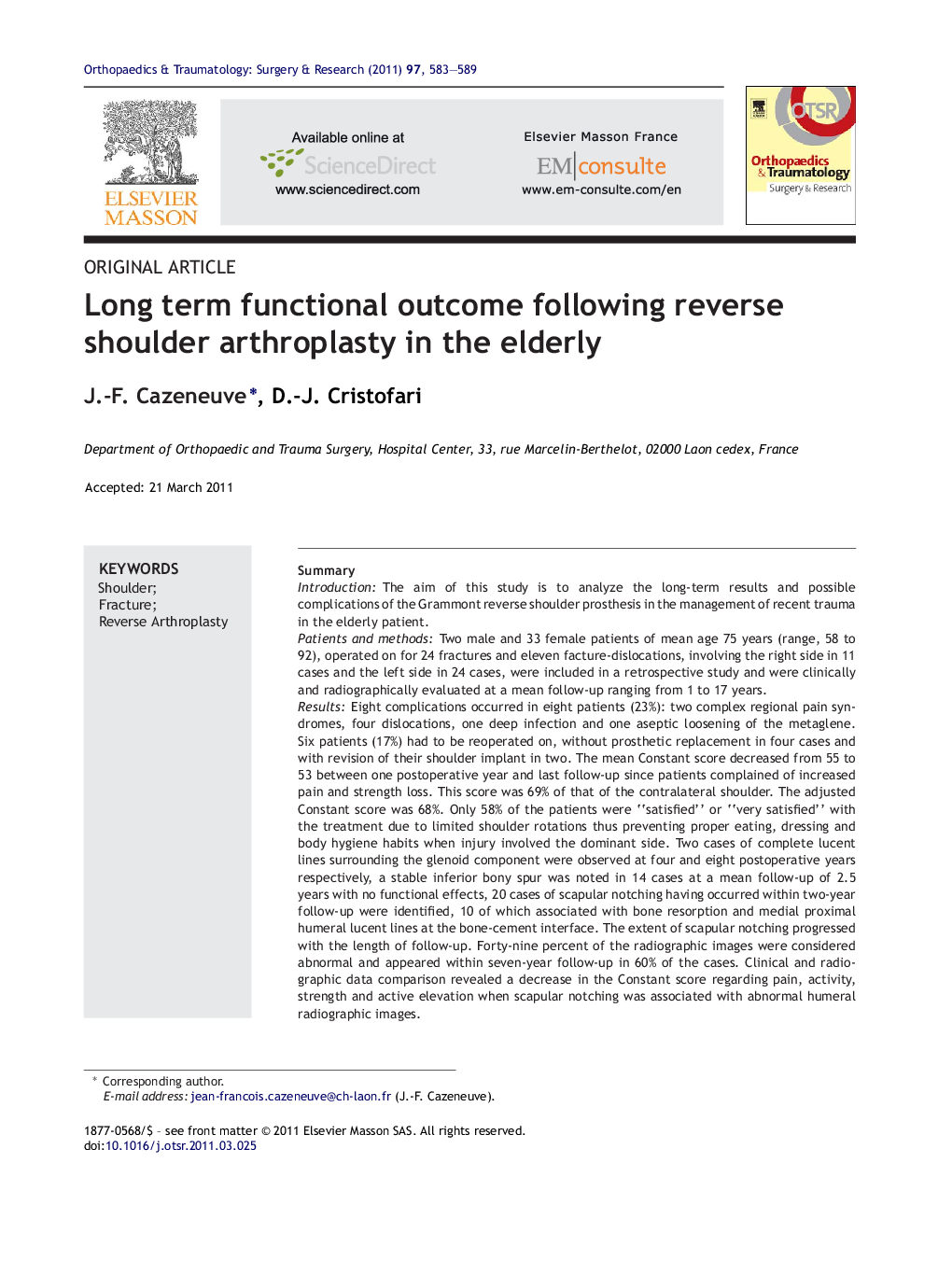| کد مقاله | کد نشریه | سال انتشار | مقاله انگلیسی | نسخه تمام متن |
|---|---|---|---|---|
| 4081903 | 1267614 | 2011 | 7 صفحه PDF | دانلود رایگان |

SummaryIntroductionThe aim of this study is to analyze the long-term results and possible complications of the Grammont reverse shoulder prosthesis in the management of recent trauma in the elderly patient.Patients and methodsTwo male and 33 female patients of mean age 75 years (range, 58 to 92), operated on for 24 fractures and eleven facture-dislocations, involving the right side in 11 cases and the left side in 24 cases, were included in a retrospective study and were clinically and radiographically evaluated at a mean follow-up ranging from 1 to 17 years.ResultsEight complications occurred in eight patients (23%): two complex regional pain syndromes, four dislocations, one deep infection and one aseptic loosening of the metaglene. Six patients (17%) had to be reoperated on, without prosthetic replacement in four cases and with revision of their shoulder implant in two. The mean Constant score decreased from 55 to 53 between one postoperative year and last follow-up since patients complained of increased pain and strength loss. This score was 69% of that of the contralateral shoulder. The adjusted Constant score was 68%. Only 58% of the patients were “satisfied” or “very satisfied” with the treatment due to limited shoulder rotations thus preventing proper eating, dressing and body hygiene habits when injury involved the dominant side. Two cases of complete lucent lines surrounding the glenoid component were observed at four and eight postoperative years respectively, a stable inferior bony spur was noted in 14 cases at a mean follow-up of 2.5 years with no functional effects, 20 cases of scapular notching having occurred within two-year follow-up were identified, 10 of which associated with bone resorption and medial proximal humeral lucent lines at the bone-cement interface. The extent of scapular notching progressed with the length of follow-up. Forty-nine percent of the radiographic images were considered abnormal and appeared within seven-year follow-up in 60% of the cases. Clinical and radiographic data comparison revealed a decrease in the Constant score regarding pain, activity, strength and active elevation when scapular notching was associated with abnormal humeral radiographic images.DiscussionDespite one single case of aseptic loosening of the metaglene at 12-year follow-up, the results of our series are clinically disappointing and radiographically worrying associated with a substantial rate of complications and reopperations. The long-term functional outcome is far from being identical to the pre-trauma clinical status with a potential evolution toward loss of autonomy when the dominant side is affected. New prosthetic design characteristics and surgical technique improvements should be implemented to improve shoulder adduction but also rotations while preventing the occurrence of scapular notching. In the light of these results, we cannot validate the concept of primary reverse shoulder arthroplasty in the management of recent trauma of the proximal humerus.Level of evidenceLevel IV. Retrospective study.
Journal: Orthopaedics & Traumatology: Surgery & Research - Volume 97, Issue 6, October 2011, Pages 583–589